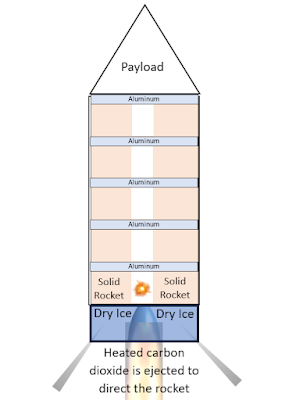This is the fourth stage of the rocket I had proposed earlier. It will mostly travel through space to achieve the orbital velocity. It will be a slightly modified version of the Sliding Sectioned Solid Rocket (SSSR) I had proposed earlier.
The new version of the SSSR will have stationary payload bay. Only the solid propellent will slide downward as the fuel is consumed. The SSSR works as follows: The solid rocket propellent will be ignited at the bottom of the rocket. Initially, this ignition will not propagate to the upper propellent because it will be confined by the aluminum separator. The composition of the propellent will contain more oxidizer than the fuel. The additional oxidizer will burn through the aluminum separator and ignite the upper propellent section.
The propellent will not be in direct contact with the walls of the rocket. A sheet of low-density polyethylene will be in between. Due to the heat inside the rocket, this low melting plastic will decompose into methane and ethane which will then be burned by the oxidizer. As result, the solid propellent will slide downward restricting the combustion area. By restricting the combustion volume, the thrust will be kept almost constant and the specific impulse of the rocket will increase.
The rocket will have a carved nozzle from a heat resistant ceramic. However, this ceramic will not be too thick to isolate all the heat. Some of this heat will be transferred to the trapped dry ice (solid carbon dioxide). Heated carbon dioxide gas will be used to steer the rocket. This will eliminate the complex gimbaled nozzle design.

No comments :
Post a Comment